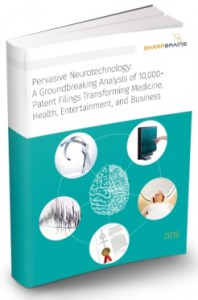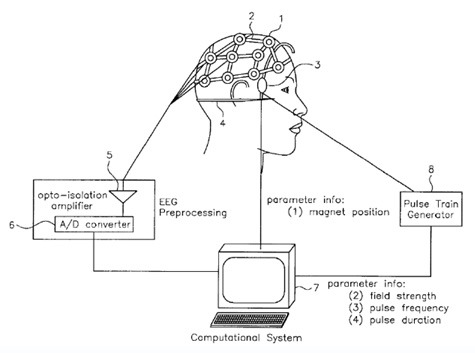Monitoring and stimulating brain activity to achieve desired brain state: Key Neurotech Patent #10
Today we are sharing a 2002 patent describing a system linking brain signal detection to brain stimulation techniques.
U.S. Patent No. 6,488,617: Method and device for producing a desired brain state
- Assignee(s): Universal Hedonics
- Inventor(s): Bruce F. Katz
- Technology Category: Hybrid
- Issue Date: December 3, 2002
SharpBrains’ Take:
The ‘617 patent describes a system linking brain signal detection to brain stimulation techniques with the purpose of achieving a desired brain state. Cited examples of desired brain states in the background section of the patent include high neural activity in the alpha frequency band (8–13 Hz) that may be correlated with a feeling of relaxation or balancing of asymmetrical activity between the right and left prefrontal cortex that has been correlated with depression. With only two illustration sheets and four pages of written description, the specification may be considered somewhat limited. Nevertheless, the independent claims map well to the inventive concept of a closed loop detection-stimulation system. These independent claims, along with the multiple recited modes of brain state detection (e.g., MEG, EEG, MRI, etc.) and a fairly early priority date (dating back to 2000) are amongst the factors making the ‘617 patent a key non-invasive neurotechnology patent.
Abstract:
A method and device for the production of a desired brain state in an individual contain means for monitoring and analyzing the brain state while a set of one or more magnets produce fields that alter this state. A computational system alters various parameters of the magnetic fields in order to close the gap between the actual and desired brain state. This feedback process operates continuously until the gap is minimized and/or removed.
Illustrative Claim 22. A device for producing a desired brain state in an individual by measuring and controlling a brain signal comprising;
- means for measuring a brain signal indicating a brain state of an individual;
- a computational system for comparing characteristics of the measured brain state to characteristics of a desired brain state to determine the difference between the measured brain state and the desired brain state; and
- means for applying a magnetic field having parameters to the brain of the individual to alter the brain state, the parameters being magnet position, field magnitude, pulse frequency, and pulse train duration.
 To learn more about market data, trends and leading companies in the digital brain health space –digital platforms for brain/ cognitive assessment, monitoring and enhancement– check out this market report. To learn more about our analysis of 10,000+ patent filings, check out this IP & innovation neurotech report.
To learn more about market data, trends and leading companies in the digital brain health space –digital platforms for brain/ cognitive assessment, monitoring and enhancement– check out this market report. To learn more about our analysis of 10,000+ patent filings, check out this IP & innovation neurotech report.



